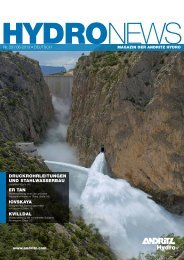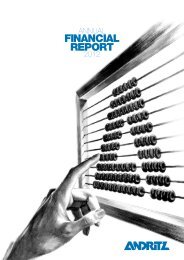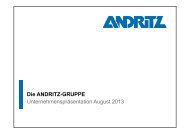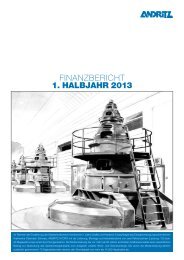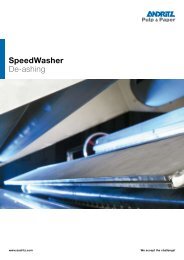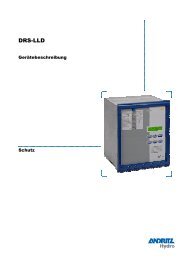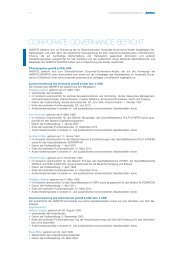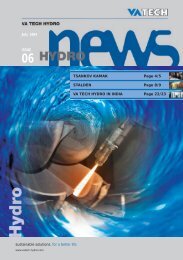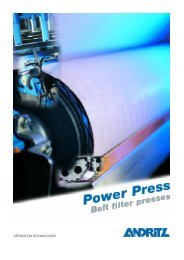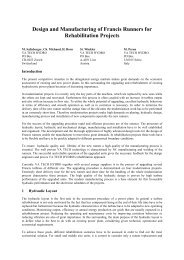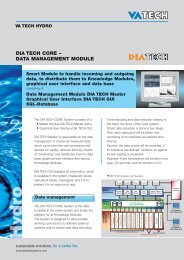The customer magazine of Andritz Pulp & Paper Issue 1— 2004
The customer magazine of Andritz Pulp & Paper Issue 1— 2004
The customer magazine of Andritz Pulp & Paper Issue 1— 2004
You also want an ePaper? Increase the reach of your titles
YUMPU automatically turns print PDFs into web optimized ePapers that Google loves.
<strong>The</strong> new <strong>Andritz</strong> 3300 m 3 /d wood line at Hallsta.<br />
<strong>The</strong> Photo shows the Waplans hydrostatic bearing<br />
debarking drum (5.6 m diameter and 36 m long) with<br />
a capacity <strong>of</strong> 175 m 3 sub/hr. For TMP, the debarking<br />
process must guarantee a high level <strong>of</strong> chip<br />
cleanliness (typically bark content <strong>of</strong> 0.1 to 0.2%).<br />
<strong>The</strong> <strong>Andritz</strong> DrumMatic TM control system at Hallsta<br />
ensures uniform cleanliness.<br />
Wood sorting for<br />
natural brightness<br />
In 1999, <strong>Andritz</strong> supplied a new wood<br />
processing line to replace two older<br />
lines, which were scrapped. <strong>The</strong> new<br />
<strong>Andritz</strong> line has a capacity <strong>of</strong> 3,300 m 3<br />
per day and consists <strong>of</strong> a log infeed<br />
system, debarking drum, and chipper.<br />
<strong>The</strong> mill's woodyard plays a key role<br />
in the drive for both product quality and<br />
environmental protection. Here, spruce<br />
logs are sorted as they come into the<br />
mill based on the annual growth rings<br />
in the wood. In a method that Holmen<br />
helped create in the mid-1990's, this<br />
rough sorting is used to separate the<br />
wood into three categories. <strong>The</strong> fastest<br />
growing logs, with the highest annual<br />
growth increments, are used for the<br />
highest brightness pulp.<br />
Lennart Karlsson, Process Engineer.<br />
"We are very satisfied with the installation."<br />
In this manner, says Lennart Karlsson,<br />
Process Engineer at Hallsta, the mill<br />
saves on bleaching chemicals and<br />
reduces the environmental load. "As we<br />
moved to improved grades with higher<br />
brightness requirements, it seemed logical<br />
to attempt to use the natural brightness<br />
<strong>of</strong> the wood," Karlsson says. "So<br />
the brightest chips are used for the highest<br />
qualities, therefore saving bleaching<br />
chemicals and, <strong>of</strong> course, money."<br />
<strong>Issue</strong> 1 — <strong>2004</strong> FiberSpectrum 15



